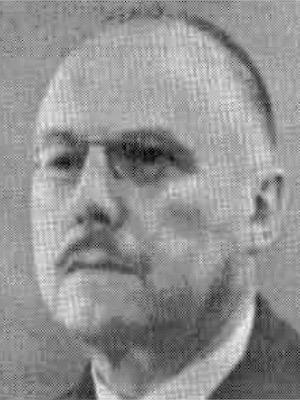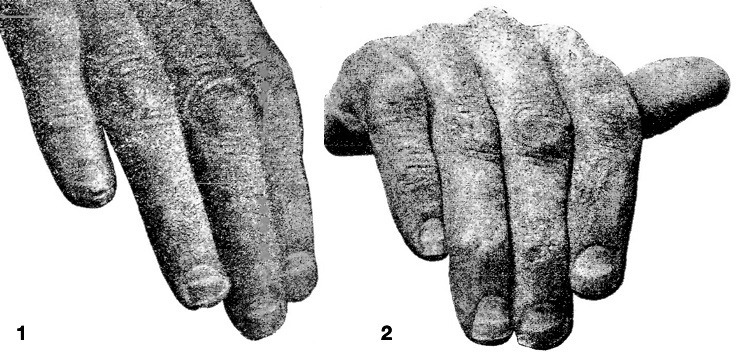Rudolf A. Mees
Rudolf Adriaan Mees (1873-1964) was a Dutch psychiatrist and physician.
Mees described in 1918 (published 1919) three patients with ‘polyneuritis arsenicosa’ (polyneuropathy due to acute arsenic intoxication) as a result of ingesting a large single dose of arsenic salts. He discussed two cases of attempted suicide and one of attempted murder.
Eponymously remembered for his description of the nail sign known as ‘Lijnen van Mees’ Mees lines in acute arsenic poisoning
Biography
- Born on October 14, 1873 in Deventer, Overijssel, Netherlands
- Geneesheer aan het Provinciaal Ziekenhuis “Duin en Bosch” te Bakkum [Physician at the Provincial Hospital “Duin en Bosch” in Bakkum]
- 1918 – Described and published on Mees Lines: Naar een voordracht, gehouden in de vergadering van de Vereeniging voor Psychiatrie en Neurologie op 11 October 1918
- Geneesheer-directeur het Provinciaal Ziekenhuis te Santpoort
- Psychiater te Bloemendaal
- Died on June 7, 1964 in Overveen, Bloemendaal, Netherlands
Medical Eponyms
Mees lines (1919)
Nail sign: white bands (leukonychia striata) traversing the full width of the (finger/toe) nail, running parallel to the lunula, with no palpable ridges. As the nail grows they bands move distally and finally disappear when trimmed. This finding is indicative of heavy metal poisoning particularly arsenic, thallium and selenium within the last year. The sign has also been recorded in patients with renal dysfunction; chemotherapy; cardiac failure; systemic illness and high altitude mountaineering.
Mees described in 1918 (published 1919) three patients with ‘polyneuritis arsenicosa’ (polyneuropathy due to acute arsenic intoxication) as a result of ingesting a large single dose of arsenic salts. He discussed two cases of attempted suicide and one of attempted murder.
Op de foto’s is het vershijnsel duidelijk waar te nemen. Over de nagels ziet men witte dwarsbanden loopen, die duidelijk niets met de lunula te maken hebben, aangezien onder den band, even goed als er boven, de nagel normaal rood van kleur is. Zooals begrijpelijk is, groeit dexe dwarsband met den nagel op en bij vergelijking van fig 1 met fig 2 ziet men een duidelijke verschuiving naar de peripherie van den nagelband op de laaste figuur…De breedte van den nagelband is ongeveer 1.5mm…Alle nagels van handen en vooten vertoonen denzelfeden dwarsband; hij is echter op de teenen veel minder duidelijk dan op de vingers
The phenomenon is clearly visible in the photos. White transverse bands are seen running over the nails, which clearly have nothing to do with the lunula, since under the band, as well as above, the nail is normally red in color. This transverse band grows with the nail and when comparing Fig. 1 with Fig. 2, a clear shift is seen towards the periphery of the nail band on the last figure…The width of the nail band is about 1.5mm…All nails of hands and feet show the same cross-band; however, it is much less clear on the toes than on the fingers
Mees suggested the use of the nail sign in diagnosing polyneuropathy due to acute arsenic intoxication
Waneer mocht blijken, dat bij polyneuritis arsenicose deze nagelband steeds aanwezig is van de tweede maand na de toediening van het vergift af en ongeveer twee maanden zeer duidelijk aanwezig blijft, dan kandit verschijnsel forensische beteekenis hebben. De band toch is nog aanwezig, als het arsenicum uit de urine is verdwenen. Een moeilijk te diagnosticeeren geval van polyneuritis zou dan door het aanwezig zijn van den nagelband asl polyneuritis aresenicos kunnen worden herkend.
If it turns out that in polyneuropathy due to acute arsenic intoxication this nail band is always present from the second month after the administration of the poison and remains very clearly present for about two months, this phenomenon can have forensic significance. The band is still present when the arsenic has disappeared from the urine. A case of polyneuropathy that is difficult to diagnose could then be recognized by the presence of the nail band as polyneuropathy due to acute arsenic intoxication
Major Publications
- Mees RA. Een Verschijnsel bij Polyneuritis Arsenicosa, Nederlands tijdschrift voor geneeskunde 1919; 63(1a): 391-396 [PDF]
References
Biography
- Portrait: Rudolf Adriaan Mees. In: Kroniek van de stichting geslacht Mees 1999; 48: 8
- Rudolf Adriaan Mees. Descendants of Joris Mees. [#199]
Eponymous terms
- Zhang G. Mees lines. Eponym A Day, Instagram
[cite]


